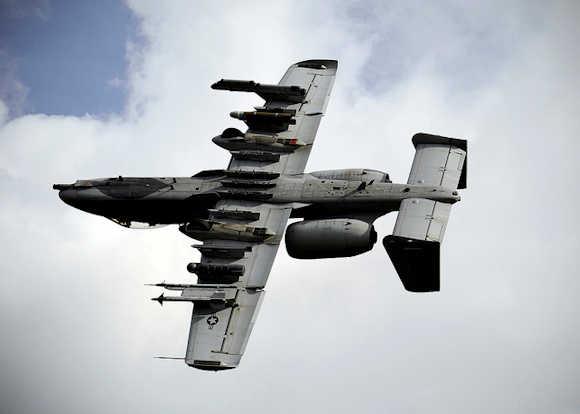"There is no justification for retiring the A-10 fleet. In doing so we would leave our soldiers at the mercy of security challenges around the world. "
The Government Accountability Office, in a note countersigned by the Senate Armed Forces Commission, severely attacks the retirement plan proposed by the Air Force for the A-10.
"The Air Force claims that to meet new challenges in theaters like the Pacific, you need to buy multi-role aircraft like the F-35. The Air Force estimates that it would save 4.2 billion dollars over the next five years should A-10 retire. The GAO has not yet well understood the methodology identified by the service to estimate these savings, but the Air Force has not established the clear requirements of the missions carried out by the A-10. In the absence of such requirements, the Air Force has not fully identified the gaps and capabilities that it would lose by retiring the A-10. A mitigation strategy is lacking to make up for the loss of the platform Warthog".
The GAO also attacks the Department of Defense. "They should develop the guidelines to establish the specific requirements to be met before proposing the retirement of the main weapon system that, after the upgrades, has not reached the end of the life cycle". The GAO advises the Air Force to focus on platforms that are now nearing the end of their service.
Aviation forgets - conclude from GAO - that for other platforms, such as the B-52, they have been extended without problems.
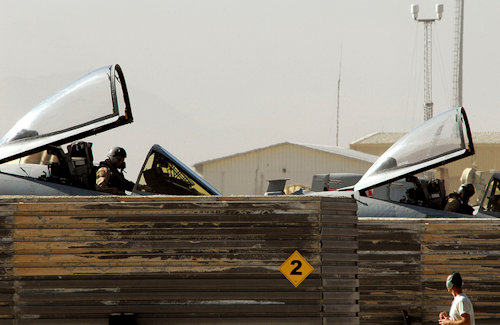 The A-10 Warthog was built in 715 specimens. The Air Force has abandoned four A-10 squadrons from the 2012 to today, while those that are still in service have switched from 24 to 18 aircraft. The Pentagon deploys nine squadrons in the world in four operational theaters: South Korea, Iraq and Syria, Eastern Europe and the Philippines.
The A-10 Warthog was built in 715 specimens. The Air Force has abandoned four A-10 squadrons from the 2012 to today, while those that are still in service have switched from 24 to 18 aircraft. The Pentagon deploys nine squadrons in the world in four operational theaters: South Korea, Iraq and Syria, Eastern Europe and the Philippines.
Built at the end of the 70 years, they have been redesigned to fly up to the 2028 (next step 2040). This figure should not make you scream in scandal: just think that the B-52 fleet will fly up to the 2040. The Pentagon recently invested a billion dollars in equipping the A-10 with a new cockpit, fire control system and an HMD (helmet-mounted display) implemented on the helmet.
The controversies on the A-10 arise from the need to free up funds to be allocated to the F-35 which, in theory, was also presented as an aircraft in the CAS role. We know it's not like that. The universal hunting project, both in terms of the components in common for the three variants and the multi-role role, has long failed officially. The Navy is developing its own specific fighter, while the Air Force presses to reopen the line Raptor.
The sacrifice of the A-10 was deemed necessary to ensure the economic flow for the F-35. Unfortunately, as we have repeated several times, the F-35 tactical fighter will never play the missions of the Warthog and match its historically undervalued close support capabilities. Finally, there is the atavistic diatribe between the Air Force and the troops on the ground.
After the initial phase (lasting years) for the all-inclusive JSF, the Pentagon also admitted the reality of the facts, authorizing the AX program (natural substitute of A-10).
What will happen now? GAO, Armed Forces Commission of the Senate and the Chamber, as well as the Congress have already expressed their binding point of view on several occasions: the A-10 is not touched.
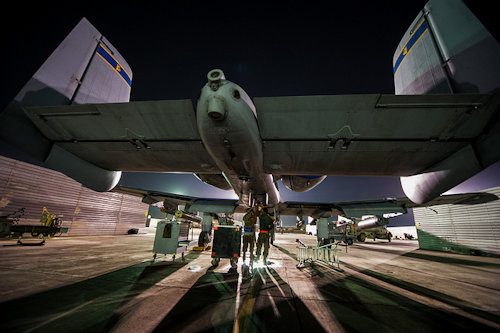 The A-10 will remain in service until the decision of the AX program which, as we know, provides three options: to build a new one Warthog, use current assets to fulfill CAS missions or extend the life of the A-10 up to the 2040 / 45. Despite budgetary pressures and the need to free up resources to be allocated to the F-35 program, the Air Force in its latest budget request shelves the final retirement plans at 2022, proposing the withdrawal of 49 aircraft within the 2018. Instead, Congress has frozen any A-10 retirement until the capabilities of the platform that replaces it will be proven.
The A-10 will remain in service until the decision of the AX program which, as we know, provides three options: to build a new one Warthog, use current assets to fulfill CAS missions or extend the life of the A-10 up to the 2040 / 45. Despite budgetary pressures and the need to free up resources to be allocated to the F-35 program, the Air Force in its latest budget request shelves the final retirement plans at 2022, proposing the withdrawal of 49 aircraft within the 2018. Instead, Congress has frozen any A-10 retirement until the capabilities of the platform that replaces it will be proven.
The lethality, survival and unique ability to provide continuous close-up air support to the A-10 is unrivaled. The A-10 can fly over the battlefield for 90 minutes, while the F-35A can only stay for 20 / 30 minutes. The A-10 can fire more than 1.170 shots, while the F-35A only has 180 bullets. The A-10 can remain in flight even after losing some of its primary systems, the F-35A cannot survive a direct hit. No other western aircraft could continue its mission under the fire of 23mm guns and against some from 57 mm. Every vital part of the A-10 is protected by armored plates. The pilot is no exception, wrapped in a titanium “tank” of 600 kg. It should be noted that while on the one hand the A-10 was designed to operate in an operating context of an earlier era, today it remains however more vulnerable than the other platforms in the face of new threats. The new CAS platform of the AX program must therefore be designed to guarantee close support in an environment that has modern and stratified defense systems. The A-10, today can only operate in permissive environments.
Warthog 2.0
The AX program, compared to the previous ones, also contemplates the possibility of upgrading the existing cells which will have to comply with the requirements set by the Air Force. If so, the Air Force (to save time and money) could bet everything on one Warthog 2.0. A new platform therefore, which would preserve the current capabilities of the A-10, improving the criticalities such as, for example, the low power of the General Electric TF-34. The latter do not allow the A-10 to take off at full load.
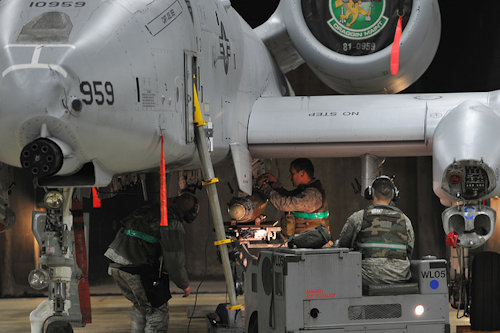
The CAS role does not require hypersonic aerodynamic profiles. That's why the cruising speed (360 nodes ideally) will still have to be aerodynamically compatible with a tight turning radius at low speed. The new aircraft should be able to make a minimum of twenty attacks against infantry targets or eleven attacks on tanks during a single sortie. Furthermore, the Warthog 2.0 it may also be able to hit moving targets at eight nautical miles away at altitudes above the 20.000 feet. In terms of survival, any new generation CAS aircraft will need to have two engines and several redundant systems. It will have to withstand blows from 7,62 / 14,5 millimeters and cannon fire from 23 millimeters. It will have to survive even if hit by an SA-18 missile.
But there is a key element that will be an essential part of the new A-10: the GAU-8 cannon from 30 millimeters. The AX program aims at the realization (as happened for the A-10) of an armored system to take the most powerful airborne tactical weapon on the planet: the gatling type gun from 30 mm to seven GAU-8 rotating barrels Avenger. It is capable of destroying a tank at 7 km away.
The most powerful aviation in the world that is based on cells with an average life of 23 years, is already financing a new bomber, the B-21, a new tanker, the KC-46, the F-35 and the program AX. Finally, the possibility that the Air Force could consider not one, but two substitutes for the A-10 Warthog in Close Air Support based on the Embraer A-29 Super Tucano / Textron Beechcraft AT-6 and an unveiled U-CAV equipped with a XUUMX millimeter GAU-8 cannon.
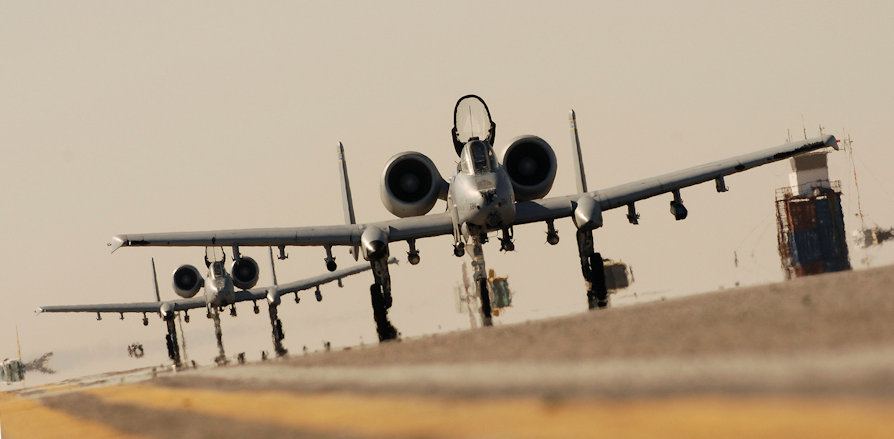 (photo: US DoD)
(photo: US DoD)

